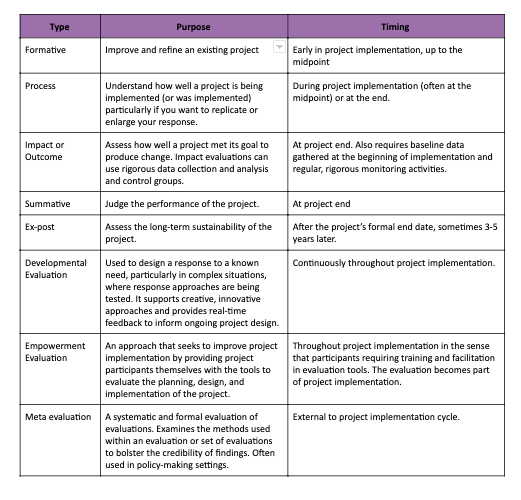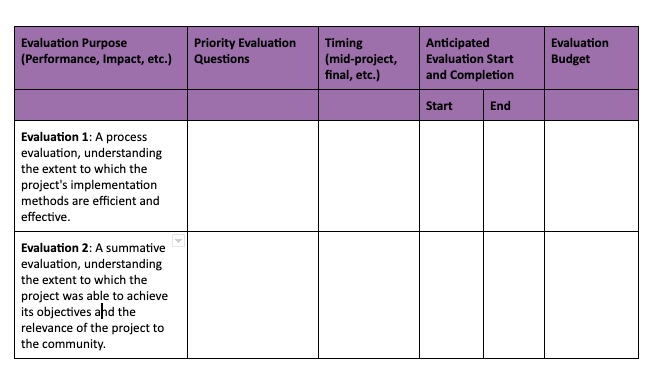Evaluation Plans
I want to plan for systematic assessment of an ongoing or completed project...
What is it?
Evaluation is the user-focused, systematic assessment of an ongoing or completed project.
Evaluations help determine whether a project will, or has already achieved its objectives. They also help identify unintended changes, positive or negative, experienced by communities. Learning from evaluations informs recommendations to improve ongoing programs and strategic decision-making about future projects.
All projects should include some sort of evaluation activity. Small projects may choose a very light, simple evaluation activity. Other projects, especially large, multi-year initiatives, commit to conducting more complex evaluations in addition to the regular monitoring activities identified in the performance management plan.
As projects plan for evaluation activities, there are two tools that can help: the Summary Evaluation Table (SET) and the Evaluation Terms of Reference (ToR).
SUMMARY EVALUATION TABLE (SET)
The SET is a table that documents key decisions about your evaluation plans, including:
- The evaluation purpose
- The priority evaluation questions
- The evaluation timing
- The evaluation budget.

EVALUATION TERMS OF REFERENCE (ToR)
The evaluation ToR is a much more detailed evaluation planning document than the SET. It provides updated and more detailed evaluation questions based on experience and learning gained since the SET was developed. It also includes details related to data collection methods, and evaluation roles and responsibilities.
At a minimum, the ToR should include the following information:
- Project introduction and background
- Evaluation purpose, audience and use
- Evaluation criteria and questions
- Methodological approach
- Evaluation roles and responsibilities
- Evaluation deliverables and timelines
- Evaluation logistics and support.
How do I use it?
SUMMARY EVALUATION TABLE
Developing a summary evaluation table (SET) requires an understanding of what you need to know and when you need to know it. Much of this information can be found in your project logframe and the performance management plan, which will help you complete the various sections of the SET.
Evaluation Purpose
This column of the SET requires teams to consider the type and purpose of the evaluation. The table below identifies some of the many evaluation types and describes each type’s purpose and timing.

As you identify the purpose of your evaluation (and the type of evaluation you intend to conduct) ask yourself, “What are we trying to evaluate?” For example, are you interested in evaluating:
Project Relevance
Project Relevance: The extent to which the project is relevant to the priorities, needs and opportunities of the target group, recipient and donor.
Project Efficiency
Project Efficiency: The extent to which the project uses the least costly resources possible to achieve the desired results. This generally requires comparing alternative approaches to achieving the same outputs, to see whether the most efficient process has been adopted.
Project Effectiveness
Project Effectiveness: The extent to which a project attains its objectives.
Project Impact
Project Impact: The positive and negative changes produced by a development intervention, directly or indirectly, intended or unintended.
Project Sustainability
The image below provides an example of the Evaluation Purpose column of the SET:

Evaluation Questions
After the identification of the evaluation type and purpose, the SET outlines the key evaluation questions. The ultimate usefulness of an evaluation is dependent on the creation of well-defined evaluation questions.
These questions reflect stakeholder information needs and are associated with evaluation criteria. They are very clear statements of what teams need to know from the evaluation. The specific evaluation methodology, including the data gathering methods and tools and analysis and interpretation plans, is guided by these questions.

Evaluation Timing
Next, complete the evaluation timing section of the SET. The timing of your evaluation will be based on your information needs and the evaluation purpose. The SET should be specific about the start and end date of the planned evaluation.
Evaluation Budget
Finally, complete the evaluation budget column of the SET. The evaluation budget figure identifies the total amount allocated for the evaluation or evaluations. Usually the amount can be found in the overall project budget.
EVALUATION TERMS OF REFERENCE
The evaluation terms of reference is created using the SET as a guide. One ToR is created for each evaluation planned for the project, spelling out the details of the evaluation purpose, questions, proposed methodology, timing, logistics and support.
The ToR is both a planning tool and a tool used for hiring external consultants if needed.
When do I use it?
Evaluations are generally timed at the mid-term or end of project implementation. Mid-term evaluations usually focus on generating recommendations to improve ongoing programming, while final evaluations focus on measuring impact and documenting learning.
The development of a SET should be a part of initial project planning. Evaluations are often required by donors, meaning that a SET can even be developed within a project proposal.
The Evaluation Terms of Reference is created closer to the time of the evaluation and is informed by not only the SET but also experience and data collected to date.
Tips:
Tip 1: Collaborate on SET Design
Planning evaluations, particularly regarding the timing and the budget, must be done in collaboration with the larger project team and stakeholders. This kind of collaboration will ensure that you have the time and resources (budget, staff, supplies, vehicles, etc.) needed to conduct your planned evaluation activities.
Tip 2: Be realistic when selecting evaluation questions
Be realistic about the number of questions you include in your SET and ToR. Include only the questions that you need to answer and that can be realistically answered within the timeframe and budget available to the project.

Supported by:
Shared by:
Users are free to copy/redistribute and adapt/transform
for non-commercial purposes.
© 2022 All rights reserved.




